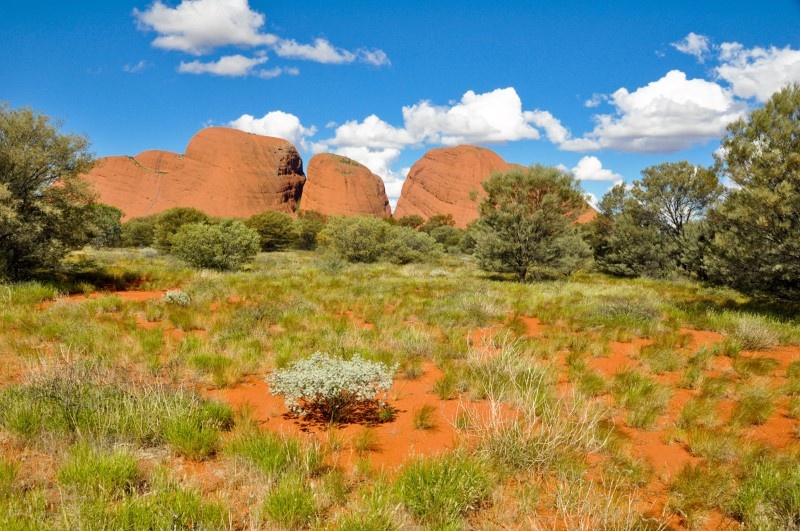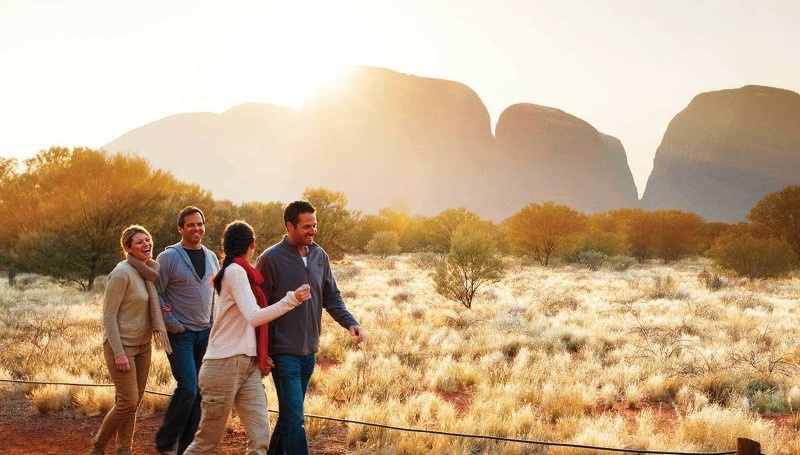
Kata Tjuta, also known as the Olgas, is a stunning geological formation located in the Uluru-Kata Tjuta National Park, about 25 kilometers (15.5 miles) west of Uluru (Ayers Rock). Consisting of 36 domed rock formations, Kata Tjuta covers an area of over 20 square kilometers (7.7 square miles) and is made of conglomerate rock composed of pebbles, cobbles, and boulders cemented together with sand and mud. The highest point, Mount Olga, rises approximately 546 meters (1,791 feet) above the surrounding plain, or about 198 meters (650 feet) higher than Uluru, making it a prominent feature of the Central Australian desert landscape.
Kata Tjuta holds great spiritual significance for the Anangu people, the traditional owners of the land. The name "Kata Tjuta" literally means "many heads" in the local Pitjantjatjara language, reflecting the site's cultural importance and the complex network of legends, beliefs, and laws that are associated with it. The Anangu people's cultural traditions dictate that certain parts of Kata Tjuta are restricted and not to be accessed or photographed by non-Indigenous people, as they are sacred sites associated with their Tjukurpa (Dreamtime) stories.
Visitors to Kata Tjuta can explore several walking trails that offer the opportunity to experience the beauty and tranquility of the landscape up close. The Valley of the Winds walk is a particularly popular trail that meanders through the domes, offering breathtaking views and a deeper connection with the natural environment. The Walpa Gorge walk is shorter and less strenuous, leading into a peaceful gorge between two of the massive rock formations.
Kata Tjuta is a place of outstanding natural beauty and cultural depth, attracting visitors from around the world who come to marvel at its unique geological features, learn about its cultural significance to the Indigenous Anangu people, and experience the serene and mystical atmosphere of this ancient landscape. The Uluru-Kata Tjuta National Park is a UNESCO World Heritage Site, recognized both for its natural and cultural values, and remains one of Australia's most iconic natural attractions.

Kata Tjuta offers visitors the chance to explore its majestic landscape through a series of walking tracks that wind through the domed rock formations. These walks provide a unique opportunity to experience the natural beauty, geological significance, and cultural depth of this ancient site within the Uluru-Kata Tjuta National Park. Each track allows for a different perspective of Kata Tjuta, catering to various fitness levels and interests.
The walks can be exposed to extreme temperatures, so it's crucial to carry plenty of water, wear appropriate clothing, and apply sunscreen. Early morning starts are recommended to avoid the heat of the day.
Exploring Kata Tjuta on foot offers an immersive experience that connects visitors with the ancient landscapes and cultural stories of this remarkable part of Australia.
Valley of the Winds Walk
Difficulty: Moderate to difficult
Length: Approximately 7.4 kilometers (4.6 miles) loop
Duration: 3 to 4 hours
The Valley of the Winds Walk is a highlight for many visitors, offering breathtaking views and a challenging trek through the heart of Kata Tjuta. The walk is named for the cool breezes that seem to whisper through the valleys, providing a serene soundtrack to the stunning visual landscape. This track takes you into the secluded areas between the domes, with two lookout points along the way – Karu Lookout and Karingana Lookout – offering panoramic views of the formation. The walk is considered moderate to difficult due to its length and the steep, rocky sections, so a reasonable level of fitness is required.
Walpa Gorge Walk
Difficulty: Easy to moderate
Length: Approximately 2.6 kilometers (1.6 miles) return
Duration: 1 to 1.5 hours
The Walpa Gorge Walk is a shorter, more accessible trek that leads into a stunning gorge between two of Kata Tjuta's massive domes. "Walpa" means "wind" in the local language, and the gorge is a pathway for the winds that flow through the area, creating a unique microenvironment. This walk is relatively easy, though it involves walking over rocky ground and slight inclines. It's well-suited for those looking for a less strenuous way to experience Kata Tjuta's grandeur up close.